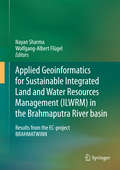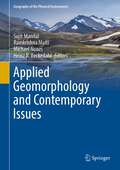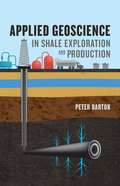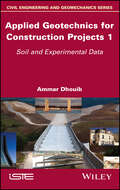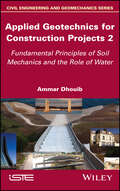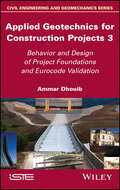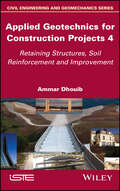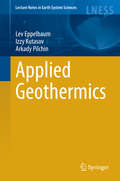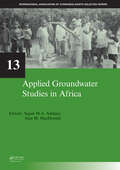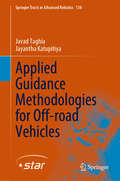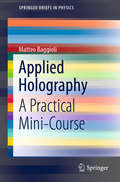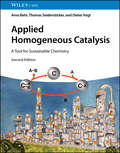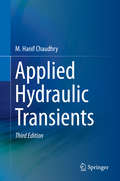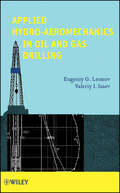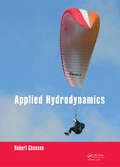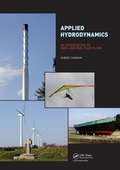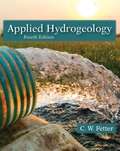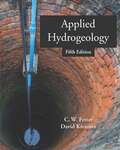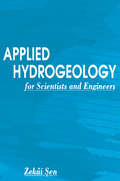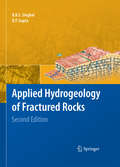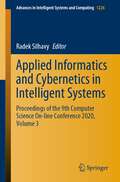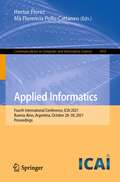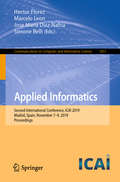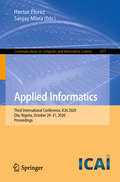- Table View
- List View
Applied Geoinformatics for Sustainable Integrated Land and Water Resources Management (ILWRM) in the Brahmaputra River basin: Results from the EC-project BRAHMATWINN
by Nayan Sharma Wolfgang-Albert FlügelThe central theme of this book is focused on the analyses and the results which emerged from the international research project BRAHMATWINN sponsored by European Commission (EC) and conducted during 2006 - 2009. The book highlights the achievements of BRAHMATWINN to carry out a harmonised integrated water resources management (IWRM) approach as addressed by the European Water Initiative (EWI) in headwater river systems of alpine mountain massifs. The latter are already impacted from climate change, and the BRAHMATWINN project established transfer of professional IWRM expertise, approaches and tools based on case studies carried out in twinning European and Asian river basins. The project addresses all important IWRM issues in a balanced way, including conflict resolution in the trans- boundary Danube and Brahmaputra River Basins in Europe and South Asia respectively. This book will be useful to researchers, professionals, managers and decision makers associated with study and application of sustainable integrated land and water resources management (ILWRM) in the backdrop of climate change.
Applied Geology: Approaches to Future Resource Management
by Marina De Maio Ashwani Kumar TiwariThis book includes a careful selection of significant contributions from international experts that were presented at the 6th AIGA Conference “Applied Geology: Approaches to Future Resource Management” that was held in the Courmayeur, Aosta Valley, Italy, from 27 - 29 June 2018. The following 7 areas are the main themes covered in this volume: · Applied Geology · Hydrogeology · Geological Exploration (underground) · Slope Instability, · Natural Hazards, Risk Assessment and Management, · Geo-resources and Sustainable Development · Application of Remote Sensing and Geographical Information Systems (GIS) The authors, from academia, research and industry present the latest state of the practice, new technologies, innovative methods and sustainable management in the field of Applied and Environmental Geology. This carefully edited work will be of value to academia, professionals, scientists and decision makers.
Applied Geomorphology and Contemporary Issues (Geography of the Physical Environment)
by Sujit Mandal Ramkrishna Maiti Michael Nones Heinz R. BeckedahlThe edited book deals with climate change and its response to river system which is one of the most burning issues of the Global environment. Due to urbanization and industrialization land degradation and resource depletion are happening and promoting livelihood challenges in the world which is reflected in the book too. The book addresses the construction of dams over large rivers and its possible consequences in the environment. Changes of the hydrology and sedimentology are to be addressed in the book. The climate change phenomena and associated geomorphic hazards and contemporary environmental issues such as sea level rise, coastal flood, drought, wind erosion, flood, soil erosion, landslide, depletion of ground water, coastal erosion etc. are elaborated in the book with suitable methods and techniques. So this edited book will contribute a lot to general to particular filed of studies and will help to geographers, geomorphologists, environmentalists, planners, policy makers and developers for studies and promoting regional plans and development.
Applied Geoscience in Shale Exploration and Production
by Peter BartokSince the year 2000, unconventional shale plays have contributed greatly to the global oil and gas supply, particularly in the United States. Understanding and managing these resources requires a unique understanding about the geology, geophysics, rock physics, and rock mechanics of each reservoir in a seamless interdisciplinary approach. Equally important, advanced technologies in seismic and microseismic processing enable professionals to map and identify the hydrocarbon resource and establish the optimum pathways for production.
Applied Geotechnics for Construction Projects, Volume 1: Soil and Experimental Data
by Ammar DhouibApplied Geotechnics for Construction Projects, Volume 1: Soil and Experimental Data
Applied Geotechnics for Construction Projects, Volume 2: Fundamental Principles of Soil Mechanics and the Role of Water
by Ammar DhouibApplied Geotechnics for Construction Projects, Volume 2: Fundamental Principles of Soil Mechanics and the Role of Water
Applied Geotechnics for Construction Projects, Volume 3: Behavior and Design of Project Foundations and Eurocode Validation
by Ammar DhouibApplied Geotechnics for Construction Projects, Volume 3: Behavior and Design of Project Foundations and Eurocode Validation
Applied Geotechnics for Construction Projects, Volume 4: Retaining Structures, Soil Reinforcement and Improvement
by Ammar DhouibApplied Geotechnics for Construction Projects, Volume 4: Retaining Structures, Soil Reinforcement and Improvement
Applied Geothermics (Lecture Notes in Earth System Sciences)
by Lev Eppelbaum Izzy Kutasov Arkady PilchinThis book describes origin and characteristics of the Earth's thermal field, thermal flow propagation and some thermal phenomena in the Earth. Description of thermal properties of rocks and methods of thermal field measurements in boreholes, underground, at near-surface conditions enables to understand the principles of temperature field acquisition and geothermal model development. Processing and interpretation of geothermal data are shown on numerous field examples from different regions of the world. The book warps, for instance, such fields as analysis of thermal regime of the Earth's crust, evolution and thermodynamic conditions of the magma-ocean and early Earth atmosphere, thermal properties of permafrost, thermal waters, geysers and mud volcanoes, methods of Curie discontinuity construction, quantitative interpretation of thermal anomalies, examination of some nonlinear effects, and integration of geothermal data with other geophysical methods. This book is intended for students and researchers in the field of Earth Sciences and Environment studying thermal processes in the Earth and in the subsurface. It will be useful for specialists applying thermal field analysis in petroleum, water and ore geophysics, environmental and ecological studies, archaeological prospection and climate of the past.
Applied Groundwater Studies in Africa: IAH Selected Papers on Hydrogeology, volume 13
by Alan MacDonald Segun AdelanaGroundwater is Africa‘s most precious natural resource, providing reliable water supplies for many people. Further development of groundwater resources is fundamental to increasing access to safe water across the continent to meet coverage targets and reduce poverty. There is also an increasing interest in the use of groundwater for irrigated
Applied Guidance Methodologies for Off-road Vehicles (Springer Tracts in Advanced Robotics #138)
by Javad Taghia Jayantha KatupitiyaThis book provides methodologies for designing and implementing guidance algorithms for autonomous vehicles. These algorithms make important decision regarding how to steer and drive a ground vehicle in order to safely stay on an intended path, thereby making the vehicle driverless. The design tools provided in this book enable the reader to develop highly practical and real-world implementable guidance algorithms that will deliver high-accuracy driving for field vehicles. (They are equally applicable for on-road vehicles.) The book covers a variety of vehicle types, including wheeled vehicles, tracked vehicles, wheeled and tracked vehicles towing trailers, and four-wheel-steer and four-wheel-drive vehicles. It also covers active trailers that are driven and steered. Vehicles used in agriculture, mining and road construction are subjected to unpredictable and significant disturbances. The robust control methodologies presented can successfully compensate for these disturbances, as confirmed by the experimental results presented. Though the majority of the methodologies presented are based on sliding-mode controllers, other robust control methodologies are also discussed. To help the reader decide which controller is best suited for his/her choice of vehicle, experimental results are presented in a comparative format.
Applied Holography: A Practical Mini-Course (SpringerBriefs in Physics)
by Matteo BaggioliThis primer is a collection of notes based on lectures that were originally given at IIT Madras (India) and at IFT Madrid (Spain). It is a concise and pragmatic course on applied holography focusing on the basic analytic and numerical techniques involved. The presented lectures are not intended to provide all the fundamental theoretical background, which can be found in the available literature, but they concentrate on concrete applications of AdS/CFT to hydrodynamics, quantum chromodynamics and condensed matter. The idea is to accompany the reader step by step through the various benchmark examples with a classmate attitude, providing details for the computations and open-source numerical codes in Mathematica, and sharing simple tricks and warnings collected during the author’s research experience. At the end of this path, the reader will be in possess of all the fundamental skills and tools to learn by him/herself more advanced techniques and to produce independent and novel research in the field.
Applied Homogeneous Catalysis: A Tool for Sustainable Chemistry
by Arno Behr Thomas Seidensticker Dieter VogtOne-stop reference on homogeneous catalysis, from general concepts through detailed examples and industrial applications Accessible and richly illustrated, Applied Homogeneous Catalysis provides a concise overview of the broad field of homogeneous transition metal catalysis and its applications in the chemical industry. This newly revised and updated second edition puts special emphasis on green chemistry, sustainable resources, and processes. The book is divided into five parts. Part I presents the basics of transition metal catalysis. Part II focuses on process engineering aspects. Part III provides details of the most important catalytic reactions. Part IV describes catalytic conversions closely related to classical homogeneous transition metal catalysis, such as nano-, electro-, photo- and organocatalysis. Part V covers new feedstocks and other topics, concluding with an outlook on future challenges of homogeneous catalysis. The book contains numerous mechanistic details, technical information, and illustrative examples. The chapters are enlivened by various excursions that relate the content to everyday life or introduce important personalities. Didactically, the book is completed with learning objectives and take-home messages for each chapter, as well as more than 400 questions and answers for self-testing. Written by a team of internationally renowned experts in the field, with a wealth of experience in industry and teaching, Applied Homogeneous Catalysis includes information on: Economic importance of industrial homogeneously-catalyzed reactions and basics of organometallic chemistry, including types of bonds, elemental steps, and mechanisms Common approaches for separating the homogeneous catalyst from the products after the reaction and using combinatorial chemistry and high throughput screening to achieve optimal results Activating “inactive” molecules such as carbon dioxide and nitrogen, and harnessing homogeneous catalysis for feedstock diversification by recycling polymers or using renewables. Providing expansive coverage of the subject, Applied Homogeneous Catalysis is an essential guide for researchers and professionals in the pharmaceutical, polymer, and fine and bulk chemicals industries working on catalysis or entering the field, as well as for Master’s and PhD students in organic chemistry, chemical engineering, and related fields.
Applied Hydraulic Transients
by M. Hanif ChaudhryApplied Hydraulic Transients, 3rd Edition covers hydraulic transients in a comprehensive and systematic manner from introduction to advanced level and presents various methods of analysis for computer solution. The book is suitable as a textbook for senior-level undergraduate and graduate students as well as a reference for practicing engineers and researchers. The field of application of the book is very broad and diverse and covers areas such as hydroelectric projects, pumped storage schemes, water-supply systems, cooling-water systems, oil pipelines and industrial piping systems. A strong emphasis is given to practical applications: several case studies, problems of applied nature, and design criteria are included. This will help the design engineers and introduce the students to real-life projects. Up-to-date references are included at the end of each chapter.
Applied Hydro-Aeromechanics in Oil and Gas Drilling
by Eugeniy G. Leonov Valeriy I. IsaevHydromechanical processes underlie the majority of technology operations in drilling, and present a crucial concern as the pace and depth of drilling increases in today's energy-hungry world. Applied Hydroaeromechanics in Oil and Gas Drilling offers a unique resource for properly modeling and understanding the hydrodynamic forces affecting a drilling site. Combining hydrodynamic theory with specific drilling applications, this coverage provides readers with a comprehensive reference for designing, planning, and optimizing drilling operations.
Applied Hydrodynamics: An Introduction
by Hubert ChansonThis textbook treats Hydro- and Fluid Dynamics, the engineering science dealing with forces and energies generated by fluids in motion, playing a vital role in everyday life. Practical examples include the flow motion in the kitchen sink, the exhaust fan above the stove, and the air conditioning system in our home. When driving a car, the air flow
Applied Hydrodynamics: An Introduction to Ideal and Real Fluid Flows
by Hubert ChansonFluid dynamics is the engineering science dealing with forces and energies generated by fluids in motion. Fluid dynamics and hydrodynamics play a vital role in everyday life. Practical examples include the flow motion in the kitchen sink, the exhaust fan above the stove, and the air conditioning system in our home. When driving a car, the air flow
Applied Hydrogeology
by C. W. FetterHydrogeology¿s importance has grown to become an integral part not only of geology curricula, but also those in environmental science and engineering. Applied Hydrogeology serves all these students, presenting the subject¿s fundamental concepts in addition to its importance in other disciplines. Fetter skillfully addresses both physical and chemical hydrogeology, highlighting problem solving throughout the book.Case studies, Excel-based projects, and working student versions of software used by groundwater professionals supplement the fourth edition¿s insightful explanations and succinct solutions to real-world challenges. Each chapter concludes with example problems, a notation of symbols, and informative analysis. A glossary of hydrogeological terms adds significant value to this comprehensive text. Fetter¿s accessible coverage prepares readers for success in their careers well beyond the classroom.
Applied Hydrogeology
by C. W. Fetter David KreamerThere is a continued demand for well-trained and competent hydrogeologists, especially in the environmental sector. For decades, Fetter's Applied Hydrogeology has helped prepare students to excel in careers in hydrogeology or other areas of environmental science and engineering where a strong background in hydrogeology is needed. The text's long-standing tradition as a vital resource is further enhanced in the fifth edition by Kreamer’s added expertise. <p><p>Stressing the application of mathematics to problem-solving, example problems throughout the book provide students the opportunity to gain a much deeper understanding of the material. Some important topics include the properties of aquifers, the principles of groundwater flow, water chemistry, water quality and contamination, and groundwater development and management. The addition of new case studies and end-of-chapter problems will strengthen understanding of the occurrence and movement of ground water in a variety of geological settings.
Applied Hydrogeology for Scientists and Engineers
by Zekai SenIn order to properly plan, design, and operate groundwater resources projects, it is necessary to measure - over time or distance - pertinent groundwater variables such as drawdown and discharge in the field. Applied Hydrogeology for Scientists and Engineers shows how to assess and interpret these data by subsurface geological setup and processing. The book helps readers estimate relevant groundwater parameters such as storativity, transmissivity, and leakage coefficient.The text addresses many interrelated disciplines such as geology, hydrology, hydrogeology, engineering, petroleum geology, and water engineering. Traditional and current models for application are presented. One of the unique features of the book is the inclusion of new and previously unpublished ideas, concepts, techniques, approaches, and procedures developed by the author. Among these are hydrogeophysical concepts, slope matching techniques, volumetric approach solution for complicated groundwater flows, non-Darcian flow law applications, aquifer sample functions, dimensionless-type straight line methods, non-linear flow-type curves, discharge calculations from early time-drawdown data, storage coefficient estimation procedure for quasi-steady state flow, and much more. The pitfalls in aquifer test analysis are also detailed. Fractured medium flow adds yet another dimension to the book. Each method is supplemented by actual field data applications from worldwide case studies.Applied Hydrogeology for Scientists and Engineers covers the topics of groundwater reservoirs, the evaluation of aquifer parameters, aquifer and flow properties, flow properties and bore hole tests, aquifer tests in porous and fractured media, well hydraulics, groundwater flow and aquifer tests, and field measurements and their interpretations.This new reference also works well as a post-graduate textbook on the subject. Applied Hydrogeology for Scientists and Engineers expands the reader's knowledge by providing valuable information not found in any other publication.
Applied Hydrogeology of Fractured Rocks: Second Edition
by B.B.S. Singhal † R. P. GuptaHydrogeology is a topical and growing subject as the earth's water resources become scarcer and more vulnerable. More than half of the surface area of continents is covered with hard rocks of low permiability. This book deals comprehensively with the fundamental principles for understanding the hydrogeological characteristics of rocks, as well as exploration techniques and assessment. It also provides in depth discussion on structural mapping, remote sensing, geophysical exploration, GIS, groundwater flow modelling and contaminant transport, field hydraulic testing including tracer tests, groundwater quality, geothermal reservoirs, managed aquifer recharge, and resources assessment and management. Hydrogeological aspects of various lithology groups, including crystalline rocks, volcanic rocks, carbonate rocks and clastic formations have been dealt with separately, using and discussing examples from all over the world. It will be an invaluable text book cum reference source for postgraduate students, researchers, exploration scientists and engineers engaged in the field of groundwater development in fractured rocks. Applied Hydrogeology of Fractured Rocks - Second Edition is thoroughly revised and extended with a new chapter, updated sections, many new examples, and expanded and updated references.
Applied Informatics and Cybernetics in Intelligent Systems: Proceedings of the 9th Computer Science On-line Conference 2020, Volume 3 (Advances in Intelligent Systems and Computing #1226)
by Radek SilhavyThis book gathers the refereed proceedings of the Applied Informatics and Cybernetics in Intelligent Systems Section of the 9th Computer Science On-line Conference 2020 (CSOC 2020), held on-line in April 2020. Modern cybernetics and computer engineering in connection with intelligent systems are an essential aspect of ongoing research. This book addresses these topics, together with automation and control theory, cybernetic applications, and the latest research trends.
Applied Informatics: Fourth International Conference, ICAI 2021, Buenos Aires, Argentina, October 28–30, 2021, Proceedings (Communications in Computer and Information Science #1455)
by Hector Florez Ma Florencia Pollo-CattaneoThis book constitutes the thoroughly refereed papers of the 4th International Conference on Applied Informatics, ICAI 2021, held in Buenos Aires, Argentina, in October, 2021.The 35 full papers were carefully reviewed and selected from 89 submissions. The papers are organized in topical sections on artificial intelligence; data analysis; decision systems; health care information systems; image processing; security services; simulation and emulation; smart cities; software and systems modeling; software design engineering.
Applied Informatics: Second International Conference, ICAI 2019, Madrid, Spain, November 7–9, 2019, Proceedings (Communications in Computer and Information Science #1051)
by Hector Florez Marcelo Leon Jose Maria Diaz-Nafria Simone BelliThis book constitutes the thoroughly refereed papers of the Second International Conference on Applied Informatics, ICAI 2019, held in Madrid, Spain, in November 2019.The 37 full papers and one short paper were carefully reviewed and selected from 98 submissions. The papers are organized in topical sections on bioinformatics; data analysis; decision systems; health care information systems; IT Architectures; learning management systems; robotic autonomy; security services; socio-technical systems; software design engineering.
Applied Informatics: Third International Conference, ICAI 2020, Ota, Nigeria, October 29–31, 2020, Proceedings (Communications in Computer and Information Science #1277)
by Sanjay Misra Hector FlorezThis book constitutes the thoroughly refereed papers of the Second International Conference on Applied Informatics, ICAI 2020, held in Ota, Nigeria, in October 2020. The 35 full papers were carefully reviewed and selected from 101 submissions. The papers are organized in topical sections on artificial intelligence; business process management; cloud computing; data analysis; decision systems; health care information systems; human-computer interaction; image processing; learning management systems; software design engineering.
